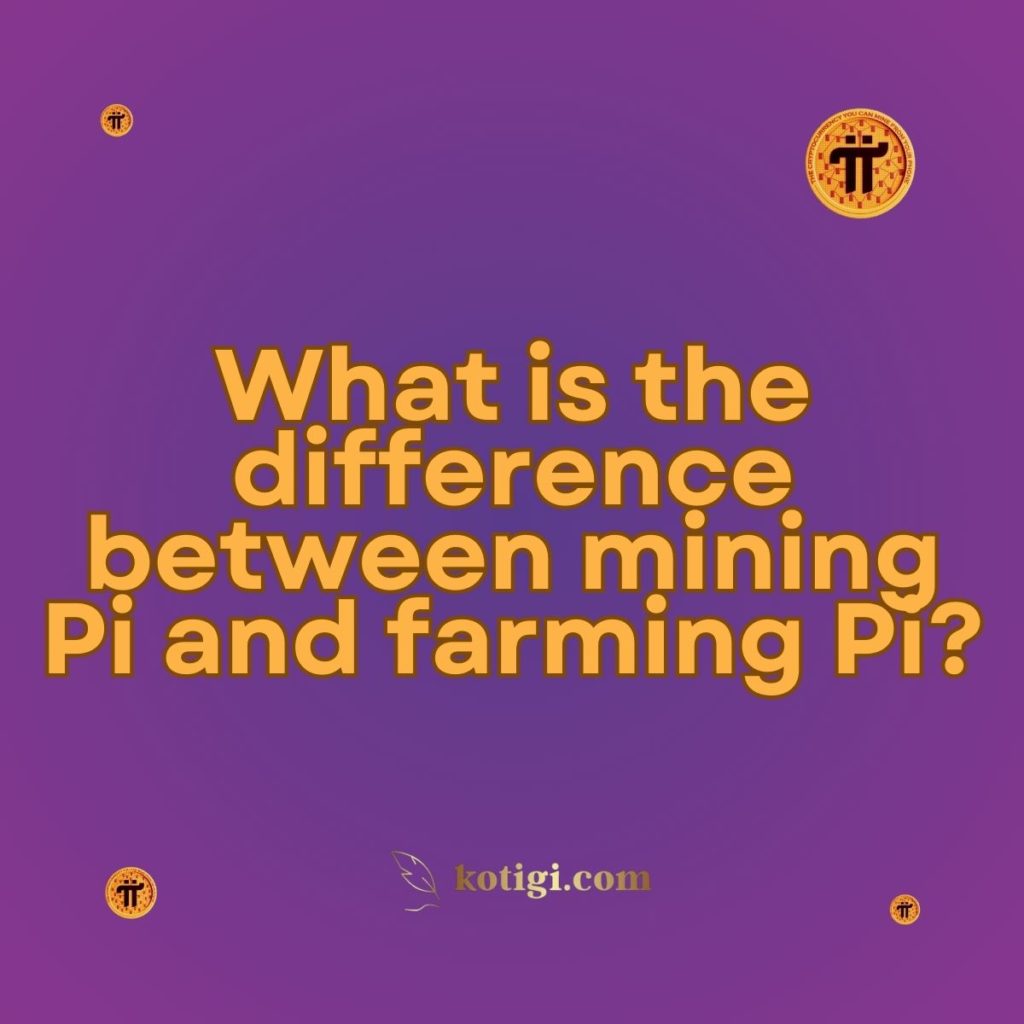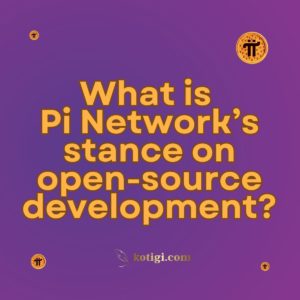
What is the difference between mining Pi and farming Pi?
Mining Pi involves earning tokens through daily app engagement, while farming Pi refers to the process of generating rewards by contributing to the network’s ecosystem in a different manner. Understanding these differences can help users optimize their involvement in the Pi Network.
Introduction
In the rapidly evolving world of cryptocurrencies, understanding the various mechanisms for earning tokens is crucial for both newcomers and seasoned users. Pi Network has introduced unique methods for users to participate in its ecosystem, namely mining and farming. While both processes enable users to earn Pi tokens, they operate on different principles and require varying levels of commitment. This blog post will explore the distinctions between mining Pi and farming Pi, examining their respective processes, requirements, rewards, and overall impacts on the Pi Network ecosystem.
Comparison table outlining the differences between mining Pi and farming Pi
Here’s a comparison table outlining the differences between mining Pi and farming Pi:
| Feature | Mining Pi | Farming Pi |
|---|---|---|
| Definition | Earning Pi tokens through daily app engagement | Generating rewards by contributing resources to the network |
| Process | Users tap the mining button daily | Users lock tokens or provide resources to the network |
| Accessibility | Open to anyone with a smartphone | May require ownership of Pi tokens and understanding of mechanics |
| Energy Consumption | Minimal; designed to be energy-efficient | Depends on contributions; generally low energy use |
| Rewards | Earned based on participation and security circles | Earned based on the level of contribution to the network |
| User Engagement | Requires daily interaction with the app | Requires active contributions and possibly locking tokens |
| Community Impact | Fosters community through security circles | Promotes engagement in network operations |
| Security Contribution | Validates transactions and maintains blockchain integrity | Enhances network functionality through contributions |
| Governance Role | Limited involvement in governance | May involve governance aspects based on contributions |
| Future Developments | Expected to evolve with network growth | Anticipated enhancements as farming mechanics develop |
This table summarizes the key differences, making it easy for users to understand the two mechanisms within the Pi Network.
1. Understanding Mining Pi
1.1 What is Mining?
Mining is the process of validating transactions and adding them to a blockchain, often requiring significant computational power and energy consumption. However, Pi Network has redefined this concept by making it accessible through a mobile app. Users can mine Pi tokens by engaging with the app daily, significantly lowering the barrier to entry compared to traditional mining methods.
1.2 How Pi Mining Works
Users earn Pi tokens by pressing a button in the Pi Network app once every 24 hours. This simple action allows users to contribute to the network’s security and transaction validation without the need for complex hardware or significant energy usage. The algorithm governing mining ensures that tokens are distributed fairly among participants, promoting inclusivity.
1.3 Rewards for Mining
The rewards for mining Pi depend on various factors, including a user’s Base Mining Rate (BMR) and their engagement level within the network. The more active users are in inviting trusted contacts to their security circles, the higher their potential rewards. This dynamic incentivizes community building and sustained engagement.
2. Understanding Farming Pi
2.1 What is Farming?
Farming, in the context of cryptocurrencies, generally refers to earning tokens through providing liquidity or other contributions to a network. It often involves locking assets in a smart contract to help facilitate transactions or support network operations. In Pi Network, farming is expected to play a crucial role as the ecosystem evolves, allowing users to generate rewards by contributing in meaningful ways.
2.2 How Pi Farming Works
While specific details about farming within Pi Network are still being finalized, the concept typically involves providing resources—such as liquidity or data—that enhance network functionality. Users may be able to lock up their Pi tokens or engage in other activities that bolster the network, thereby earning rewards over time.
2.3 Rewards for Farming
The rewards for farming Pi will likely be based on the level of contribution users make to the network. This could include receiving a share of transaction fees, additional tokens, or other incentives based on the value of their contributions. As farming mechanics develop, users will need to stay informed about how their activities can maximize their earnings.
3. Key Differences Between Mining and Farming
3.1 Process of Earning Tokens
The primary distinction between mining and farming lies in the process of earning tokens. Mining involves daily engagement with the app, while farming requires users to contribute resources or lock up tokens in a specified manner. This difference reflects the varying levels of commitment and interaction each method demands.
3.2 Accessibility
Mining is accessible to anyone with a smartphone, requiring minimal effort and technical knowledge. Conversely, farming may require users to have a certain amount of tokens or a deeper understanding of the network’s operations, which could limit participation to those more familiar with the ecosystem.
3.3 Energy Consumption
Mining in Pi Network is designed to be energy-efficient, allowing users to earn tokens without significant resource expenditure. Farming’s energy consumption will depend on the specific contributions required, but it typically does not involve the high energy costs associated with traditional mining methods.
3.4 Community Impact
Both mining and farming contribute to the Pi Network’s community, but in different ways. Mining fosters community building through security circles, while farming promotes active engagement in the network’s operations. Both methods aim to strengthen the overall ecosystem and enhance user collaboration.
4. Requirements for Mining Pi
4.1 Minimal Equipment
To mine Pi, users need only a smartphone and the Pi Network app. This accessibility makes mining an attractive option for a broad audience, enabling diverse participation without significant barriers.
4.2 Daily Engagement
Active participation is critical for mining. Users must interact with the app daily by pressing the mining button to maximize their rewards. This requirement emphasizes the importance of consistent engagement within the community.
4.3 Security Circle Participation
Building a security circle is essential for enhancing mining rewards. Users can invite trusted contacts, which increases their mining capacity. This aspect of mining fosters trust and collaboration within the network.
5. Requirements for Farming Pi
5.1 Token Ownership
To farm Pi, users may need to possess a certain number of tokens to lock up or use in their farming activities. This requirement means that users should be familiar with the token’s current value and the implications of their farming actions.
5.2 Understanding Farming Mechanics
Users interested in farming will need to understand the specific mechanics involved, including how to contribute to the network effectively. Education and awareness of farming strategies will be crucial for maximizing rewards.
5.3 Active Participation
Farming may also require ongoing participation and engagement in the network, similar to mining. Users will need to stay informed about opportunities to contribute and optimize their farming efforts.
6. Impact on Network Security
6.1 Mining and Security
Mining contributes to network security by validating transactions and maintaining the blockchain’s integrity. The active participation of miners ensures that transactions are verified and trusted within the community.
6.2 Farming and Security
Farming can also enhance network security by providing essential resources or data that support transaction processing and validation. As users contribute to the ecosystem, they help ensure the network’s reliability and robustness.
6.3 Decentralization
Both mining and farming promote decentralization by distributing power among users. This structure is crucial for ensuring that no single entity has control over the network, aligning with the core principles of blockchain technology.
7. Economic Model of Pi Network
7.1 Supply Control through Mining
The mining process plays a vital role in controlling the supply of Pi tokens, adjusting the mining rate based on user growth. This control helps maintain the token’s value and ensures sustainable distribution.
7.2 Inflation and Farming Rewards
Farming may introduce inflation as new tokens are issued as rewards for user contributions. Participants should be aware of how their farming activities can influence the overall token economy.
7.3 Balancing Both Mechanisms
Pi Network aims to create a balanced economic model that integrates both mining and farming effectively. This balance supports network growth and user engagement, fostering a thriving ecosystem.
8. Community Engagement
8.1 Mining as a Community Builder
Mining promotes community building through security circles, encouraging users to invite friends and trusted contacts. This social aspect fosters collaboration and trust among participants.
8.2 Farming as a Commitment
Farming represents a commitment to the network, as users actively contribute resources or data to enhance network operations. This commitment strengthens community ties and promotes shared goals.
8.3 User Education
Both mining and farming require user education to ensure participants understand the processes and potential rewards. The Pi Network community can benefit from resources that enhance knowledge and capabilities.
Conclusion
Understanding the differences between mining Pi and farming Pi is essential for users seeking to optimize their engagement with the Pi Network. While mining offers a straightforward and accessible way to earn tokens through daily interaction, farming introduces an alternative method that encourages active contributions to the network’s ecosystem. By exploring both processes, users can enhance their participation and potentially increase their rewards within the ever-evolving world of Pi Network.
Key Takeaways
| Key Factors | Description |
|---|---|
| Mining Process | Involves daily engagement with the app to earn Pi tokens. |
| Farming Process | Involves contributing resources or locking up tokens to earn rewards. |
| Accessibility | Mining is open to anyone with a smartphone; farming may require token ownership. |
| Energy Consumption | Mining is energy-efficient; farming’s consumption will depend on specific contributions. |
| Rewards Structure | Mining rewards vary with participation; farming rewards depend on contribution level. |
| Community Building | Mining fosters community through security circles; farming promotes active network engagement. |
| Security Contributions | Mining enhances transaction validation; farming supports network operations. |
| Future Developments | Both processes are expected to evolve as the network matures. |
| Economic Impact | Mining controls token supply; farming may introduce inflation based on rewards. |
| User Education | Both processes require understanding of mechanisms, rewards, and risks involved. |





